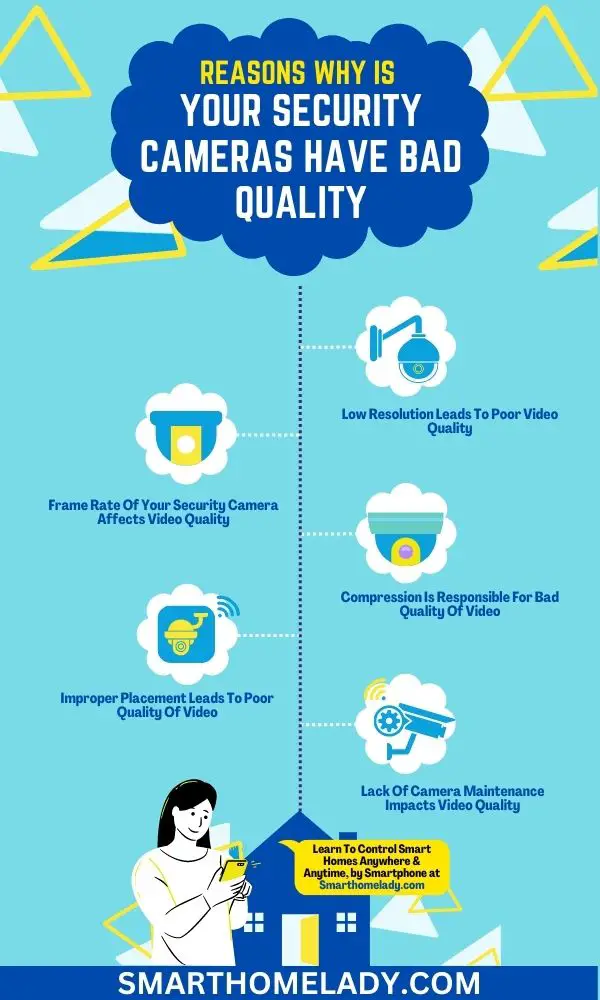Are you frustrated with the poor quality of security camera footage? Have you ever wondered why these devices, designed to provide clear and detailed images, often fail to live up to our expectations?
In this article, we will explore the 14 reasons; “Why do security cameras have bad quality?”
By understanding these factors or reasons, you will gain a deeper insight into the limitations of these devices.
In this way, you’ll be better equipped to make informed decisions when it comes to choosing and using security cameras.
So, let’s begin.

Contents
- 1 14 Reasons Why is security camera quality bad
- 1.1 1. Low Resolution Leads To Poor Video Quality
- 1.2 2. Frame Rate Of Your Security Camera Affects Video Quality
- 1.3 3. Compression Is Responsible For Bad Quality Of Video
- 1.4 4. Improper Placement Leads To Poor Quality Of Video
- 1.5 5. Lack Of Camera Maintenance Impacts Video Quality
- 1.6 6. Inadequate Configuration Of Security Cameras
- 1.7 7. Integration Issues Cause Bad Video Quality
- 1.8 8. Cost-Effectiveness & Quality Of Camera Affects Video Quality
- 1.9 9. Bandwidth & Storage Limitations Leads To Bad Video Quality
- 1.10 10. Lightening Conditions Causes Bad Video Quality
- 1.11 11. Weather Resistance is Also Responsible For Bad Video Quality
- 1.12 12. Quality Of Camera’s Lens Effects Video Quality
- 1.13 13. Format Of File Has an impact on Video Quality
- 1.14 14. Cropping Effect Video Quality Of Security Camera
- 2 Why do security cameras have such bad resolutions?
- 3 How can I make my security camera better quality?
- 4 Are 1080p security cameras worth it?
- 5 What security camera is better, 1080p or 4K?
- 6 Can you change the resolution of a security camera?
- 7 What is the highest resolution for home security cameras?
- 8 Conclusion
14 Reasons Why is security camera quality bad
When it comes to security camera quality, there are several factors that can contribute to poor video output.
Let’s discuss all the reasons in detail.
1. Low Resolution Leads To Poor Video Quality
Video resolution refers to the number of pixels that make up an image, with higher resolutions offering clearer and more detailed visuals.
Low-resolution cameras lack sufficient pixel density, leading to a loss of detail and sharpness in the images they produce.
To truly understand the impact of low resolution on security cameras, you need to experience the frustration of blurry images and distorted details firsthand.
When security camera footage is captured in low resolution, it significantly affects the overall video quality and makes it difficult to identify important details.
| Feature | Impact On Video Quality |
|---|---|
| Low Light | Insufficient lighting conditions make it challenging for cameras to capture clear footage |
| Image Sensor | Converts light into electronic signals; struggles in capturing enough light under low-light conditions |
| Video Resolution | Higher resolutions offer clearer visuals; low-resolution cameras lack pixel density |
| Camera Settings | Improper configuration impacts exposure levels and focus, affecting overall video quality |
| Video Compression | Techniques used to reduce file sizes; incorrect implementation can introduce artifacts |
2. Frame Rate Of Your Security Camera Affects Video Quality
The frame rate of your security camera has a significant impact on the clarity and fluidity of the recorded video.
A higher frame rate ensures that more frames are captured per second, resulting in smoother motion and reduced blur.
On the other hand, a low frame rate can make the video appear choppy and less detailed.
Along with video resolution, maintaining a high frame rate is crucial for obtaining clear and sharp footage from your security cameras.
Must Read: Can Security Cameras Record Audio?
3. Compression Is Responsible For Bad Quality Of Video
Compression is often the culprit behind poor video quality. When it comes to security cameras, video compression plays a crucial role in determining the final image resolution and clarity.
Video compression algorithms are designed to reduce the size of video files, making it easier to store and transmit them. However, this reduction in file size comes at a cost – video data loss.
During compression, some details from the original footage are discarded or simplified to achieve smaller file sizes. This can result in video degradation, leading to pixelation and a decrease in overall image quality.
The more an image is compressed, the more noticeable these issues become. Therefore, finding a balance between file size and video quality is essential when choosing a security camera system.
4. Improper Placement Leads To Poor Quality Of Video
Improperly positioning security cameras can result in blurry and distorted video that fails to capture important details.
To ensure optimal surveillance effectiveness, it’s crucial to consider the camera positioning carefully.
Here are four key factors that contribute to image clarity and video surveillance quality:
- Field of view – Placing the camera at an incorrect angle or height can limit its field of view, leading to blind spots or incomplete coverage of the area under surveillance. This compromises the overall effectiveness of security monitoring.
- Lighting conditions – Inadequate lighting or direct exposure to bright lights can negatively impact image quality. Shadows, overexposure, or underexposure can obscure critical details and make it difficult to identify people or objects captured on video.
- Distance from the subject – Positioning cameras too far away from the subject can result in a loss of detail and clarity. It’s essential to determine the appropriate distance based on the specific requirements of each surveillance scenario.
- Obstructions – Placing cameras behind obstacles such as trees, walls, or other objects obstruct their line of sight and hampers their ability to capture clear images. Removing obstructions and ensuring unobstructed views significantly enhances video quality.
By paying attention to camera positioning and considering these factors, you can maximize image clarity and improve the overall effectiveness of your security surveillance system.
5. Lack Of Camera Maintenance Impacts Video Quality
To ensure optimal video quality, it’s essential for you to regularly maintain and service your security cameras.
Over time, dust, dirt, and debris can accumulate on the camera lens, affecting the clarity of the recorded footage. Regular camera cleaning is necessary to remove any obstructions that may impair the quality of the video.
Additionally, checking for loose connections or damaged cables is important to prevent signal loss or interference.
Routine inspection and servicing will help identify any potential issues before they become major problems.
By taking these proactive steps in camera maintenance and video cleaning, you can guarantee that your security cameras consistently capture high-quality footage for effective surveillance purposes.
Must Read: Do Security Cameras Record All The Time?
6. Inadequate Configuration Of Security Cameras
Ensure that you properly configure your security cameras to avoid missing crucial details and potential threats, leaving you vulnerable and exposed.
An inadequate camera setup can greatly impact the quality of your surveillance footage.
- One common issue is the camera angle, which should be carefully adjusted to capture the desired area without any obstructions.
- Additionally, camera focus plays a vital role in obtaining clear images, so it’s essential to calibrate the focus correctly.
- Another aspect that often gets overlooked is camera calibration, which involves adjusting settings such as brightness, contrast, and color balance to ensure optimal video quality.
- Lastly, camera sensitivity must be appropriately set to detect motion accurately while minimizing false alarms.
By paying attention to these factors during the configuration process, you can significantly enhance the overall performance of your security cameras.
7. Integration Issues Cause Bad Video Quality
Integration issues can lead to poor video quality, leaving you with blurry and unreliable footage.
When there are integration issues with security cameras, various problems arise that can negatively impact the video quality.
- One major issue is video distortion, where the images captured by the cameras become distorted, making it difficult to identify objects or individuals clearly.
- Another problem stems from network connectivity problems, which can result in dropped frames or delayed footage, compromising the real-time monitoring capabilities of the cameras.
- Additionally, software compatibility can be an issue when different camera systems or software versions are unable to work together seamlessly, leading to a decrease in overall video quality.
- Finally, hardware limitations may also contribute to integration issues and subsequently affect the video quality. Incompatible hardware components or outdated equipment may struggle to process high-resolution videos efficiently, resulting in reduced image clarity and detail.
It is crucial for security systems to address these integration challenges effectively in order to ensure reliable and high-quality surveillance footage.
Must Read: Do Security Cameras Have To Be Visible?
8. Cost-Effectiveness & Quality Of Camera Affects Video Quality
The cost-effectiveness of camera effects plays a crucial role in determining the overall quality of the video footage captured.
When considering cost versus quality, it is important to take into account factors such as camera resolution, video compression, maintenance impact, and camera configuration.
Higher-resolution cameras tend to produce clearer and more detailed images, but they also come with a higher price tag.
Video compression techniques can reduce file sizes for easier storage and transmission but may result in some loss of image quality.
By carefully balancing cost considerations with these various aspects related to camera effects, security systems can achieve captivating visuals while maintaining an acceptable level of video quality.
9. Bandwidth & Storage Limitations Leads To Bad Video Quality
To improve the video quality, you’ll need to address the issue of bandwidth and storage limitation, which can result in blurry and pixelated footage.
Bandwidth constraints play a crucial role in determining the quality of security camera footage.
When multiple cameras are connected to a network with limited bandwidth, it leads to network congestion, causing delays and packet loss.
Network congestion can degrade the video quality as frames may be dropped or compressed excessively during transmission.
Additionally, storage limitations also contribute to poor video quality. In order to save space on storage devices such as hard drives or cloud servers, security cameras often use video compression techniques.
These techniques can sacrifice some level of detail and clarity. This compression process can introduce artifacts and image distortion, resulting in reduced overall video quality.
By optimizing bandwidth allocation and employing efficient video compression algorithms, it is possible to enhance the clarity and sharpness of security camera footage.
10. Lightening Conditions Causes Bad Video Quality
Improve your video quality by considering the impact of lighting conditions on the clarity and sharpness of footage captured by security cameras.
The performance of security cameras in low light or nighttime environments can be compromised due to inadequate lighting conditions.
Most security cameras utilize an image sensor that requires sufficient light to capture clear and detailed images. Insufficient lighting can result in grainy or blurry footage, making it difficult to identify individuals or objects accurately.
To address this issue, some advanced security cameras are equipped with night vision capabilities, allowing them to capture high-quality images even in complete darkness.
Must Read: Can Security Cameras See In The Dark?
11. Weather Resistance is Also Responsible For Bad Video Quality
Don’t overlook the impact of weather resistance on your video quality – it can make a real difference in protecting your footage from environmental elements.
When it comes to security cameras, camera durability plays a crucial role in maintaining good video quality.
Exposure to harsh weather conditions such as rain, snow, or extreme temperatures can lead to video degradation and image distortion.
By investing in cameras with strong weather resistance capabilities, you can ensure that your footage remains clear and reliable even in challenging environmental factors.
12. Quality Of Camera’s Lens Effects Video Quality
The quality of the camera’s lens directly affects the video resolution, frame rate, and overall clarity of the footage.
A high-quality lens can capture sharp and detailed images, while a low-quality lens may result in blurry or distorted videos.
Therefore, ensuring that your security camera has a high-quality lens and is properly placed can greatly improve its video resolution and overall performance.
Must Read: Can Security Cameras Work Without Electricity?
13. Format Of File Has an impact on Video Quality
Choose the right file format for your videos to ensure optimal video quality that captures all the details and colors accurately.
The format of the file has a significant impact on the overall video quality of security cameras.
Different file formats use different levels of video compression, which affects the amount of data that’s stored and transmitted.
It’s important to choose a file format that strikes a balance between storage space and video quality.
14. Cropping Effect Video Quality Of Security Camera
Video cropping refers to the process of selecting and capturing only a portion of the camera’s field of view, often done to focus on specific areas or objects.
While this technique can be useful in certain scenarios, it can have detrimental effects on video quality.
When a smaller area is cropped from the original image, the overall resolution decreases as fewer pixels are utilized to capture details.
Additionally, the camera frame rate may suffer as more processing power is required to crop and display a smaller portion of the image at a consistent speed.
Frequently Asked Questions FAQs
Why do security cameras have such bad resolutions?
Security cameras often have lower resolutions because they prioritize other important features such as low-light performance, wide-angle coverage, or durability.
Higher-resolution cameras require more bandwidth and storage capacity, which can be costly for businesses or homeowners.
Additionally, higher-resolution cameras may not always be necessary for certain surveillance needs.
For example, in a small retail store, a lower-resolution camera may provide sufficient detail to identify shoplifters or monitor employee behavior.
How can I make my security camera better quality?
To improve the quality of your security camera footage, there are a few steps you can take.
Firstly, ensure that your camera lens is clean and free from dust or debris.
Additionally, consider upgrading to a higher-resolution camera if your current one is outdated. This will provide sharper, more detailed images.
Also, check if your camera supports digital zoom, which can help enhance specific areas of interest within the frame.
Finally, investing in good lighting, either natural or artificial, can significantly improve the overall image quality, especially in low-light conditions.
Are 1080p security cameras worth it?
Yes, 1080p security cameras are worth considering. They offer a significant improvement in image quality compared to lower-resolution cameras, providing clearer and more detailed footage.
With 1080p resolution, you can easily discern important details such as faces or license plates, enhancing the effectiveness of surveillance.
Moreover, 1080p cameras are generally more affordable than higher resolution options like 4K, making them a cost-effective choice for most home or small business security needs.
What security camera is better, 1080p or 4K?
The choice between a 1080p and 4K security camera depends on your specific requirements.
If you need to capture fine details or monitor large areas, 4K cameras offer unparalleled clarity and precision. They deliver four times the resolution of 1080p cameras, resulting in incredibly sharp and detailed images.
However, it’s important to note that 4K cameras require more storage space and higher bandwidth to handle the increased data.
Additionally, 4K cameras are generally more expensive than 1080p cameras.
Therefore, if you have limited storage capacity, a smaller budget, or don’t need extremely high-resolution footage, a 1080p camera may still provide satisfactory results.
Can you change the resolution of a security camera?
In most cases, it is not possible to change the resolution of a security camera after it has been manufactured.
The resolution is determined by the camera’s image sensor and other internal components.
However, you can choose a camera with the desired resolution when purchasing.
Therefore, it is crucial to carefully consider your surveillance needs beforehand, ensuring that you select a camera with the appropriate resolution for your specific requirements.
What is the highest resolution for home security cameras?
Currently, the highest resolution available for home security cameras is 4K Ultra HD (3840 x 2160 pixels).
These cameras offer exceptional image quality and detail, allowing you to capture fine features and objects even at a distance.
However, it’s worth noting that the higher resolution requires more storage space and bandwidth to accommodate the increased data.
Therefore, consider the trade-offs between image quality and the practicality of managing and storing the footage when deciding on the resolution for your home security camera system.
Conclusion
In conclusion, the poor quality of security cameras can be attributed to several factors.
Addressing these various reasons for poor security camera quality requires careful consideration during installation, routine inspections, and maintenance checks.
You should invest in modern technology with improved resolution capabilities, ensuring sufficient bandwidth allocation for the smooth transmission of data.
By taking these steps into account and prioritizing the importance of high-quality surveillance footage, you can enhance security measures effectively.
Sources
- Human face super-resolution on poor quality surveillance video footage. (Source Link)
- Face recognition in poor-quality video: Evidence from security surveillance. (Source Link)
- Action recognition for surveillance applications using optic flow and SVM. (Source Link)


